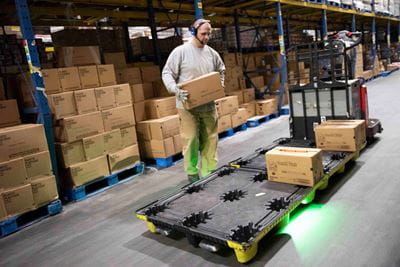Maximizing Worker and Facility Performance with Warehouse and Distribution Operator Assist Technologies
- share

Learn how operator assist technologies can boost operator efficiency and reinforce best practices in fast-paced warehouse and distribution environments.
Warehouse managers and facility operators are placing growing importance on empowering a content, engaged, self-assured workforce to enhance efficiency and productivity. And they know fostering this culture of confidence and engagement goes beyond occasional celebrations or recognition during company events. It depends on operations effectively utilizing technology to support employees. The most productive operators are those who can use the primary tool of the trade — the lift truck — to its fullest potential while staying within the appropriate operational limits. And the most progressive and forward-thinking facility managers provide their operators with the tools and technology to help them learn faster, work smarter and perform at the highest possible level.
Warehouse and Distribution Technologies Help Reduce Time to Floor and Boost Operator Confidence
Having a high rate of turnover and a small pool of qualified, experienced operators means getting new hires up to speed and onto the floor quickly is critical for companies to maintain full operational capabilities. Emerging warehousing and distribution technologies can help take the load off of overworked supervisors while giving new hires the training and peace of mind they need to operate with confidence.
Virtual Reality (VR), for example, can help new hires quickly become familiar with basic lift truck operation without the need for large areas. Hybrid learning systems incorporate VR headsets and real lift trucks to give employees the most accurate experience possible, and these systems can be scaled as new lift trucks are integrated into the fleet. VR training tools also can help more experienced operators get up to speed on new or unfamiliar equipment.
For even more powerful capabilities, Real Time Location Systems combined with fleet management systems allow supervisors to remotely manage operator certifications and vehicle access, can be configured to provide instant notification in the event of an impact, and can allow recording of vehicle and facility damage.
Improve Operator Productivity and Efficiency with Warehouse and Distribution Technologies
Real-time location and fleet management technologies also can be powerful tools to help boost efficiency. Route mapping and analysis capabilities allow managers to monitor traffic and identify bottlenecks and other congested areas and routes, and they can help managers optimize traffic patterns for a smoother flow throughout the facility. In addition, these advanced warehouse and distribution technologies can offer detailed operator metrics, giving managers actionable insight into individual operator performance.
Pick-to-light (P2L) systems can provide a big boost in operator efficiency, productivity and confidence while reducing picking errors. Working in conjunction with a warehouse management system, P2L systems can direct an operator to the correct location and item for the next pick and then tell the operator how many pieces to pick and on which customer pallet to place the picked items. P2L systems can be especially helpful for newer operators as well as for facilities dependent on temporary or seasonal labor.
Matching the Operator to the Task
Effective labor utilization means more than just right-sizing the workforce. Putting the right worker on the right task — or deciding which task to automate — is easier with the insights available from advanced location technologies and Labor Management Systems (LMS). An effective LMS should be able to analyze more than just an employee’s time spent operating a lift truck. The most valuable and actionable insights come from analysis of total time — whether it’s spent in meetings, performing “housekeeping” tasks or doing clerical or administrative work — and can help give managers a clearer picture of how each employee’s time is spent.
Reduce Risk with Warehouse and Distribution Technologies
Advanced operator assist technologies can reinforce critical training. The iWAREHOUSE Integrated Tether System, for example, can disable lift capability or limit operating speed if the operator tether isn’t detected; when combined with the appropriate warehouse management system (WMS) and telematics, these systems can provide detailed reporting on connection histories and system interventions and can offer peace of mind to operators and facility managers.
Object detection systems and proximity notification systems can bring additional layers of confidence by alerting operators when objects like structural components or other vehicles are detected in the lift truck’s path. Light detection and ranging (or LiDAR), magnetic field generation and other technologies combined with advanced on-board systems can provide the operator with audible and visual alerts regarding proximity to objects; in the event an object is detected in the lift truck’s path, the lift truck may slow to a limited speed until the object is cleared.
Helping employees perform at their best makes sense from more than just an individual perspective; engaged, high-performing workers are the “anchors” of any warehouse and distribution operation. Managers who make operator training a priority and who help their operators develop confidence as well as job skills will find their efforts repaid in improved retention, productivity and profitability.


